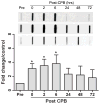Cardiopulmonary bypass is associated with hemolysis and acute kidney injury in neonates, infants, and children*
- PMID: 24394997
- PMCID: PMC3951557
- DOI: 10.1097/PCC.0000000000000047
Cardiopulmonary bypass is associated with hemolysis and acute kidney injury in neonates, infants, and children*
Abstract
Objectives: This pilot study assesses the degree of hemolysis induced by cardiopulmonary bypass and determines its association with acute kidney injury in pediatric patients. Further, it evaluates the degree to which the use of urinary biomarkers neutrophil gelatinase-associated lipocalin and cystatin C correlate with the presence of acute kidney injury and hemolysis following cardiopulmonary bypass.
Design: Prospective observational study.
Setting: A 13-bed pediatric cardiac ICU in a university hospital.
Patients: Children undergoing cardiac surgery with the use of cardiopulmonary bypass.
Interventions: None.
Measurements and main results: Blood and urine samples were obtained at multiple time points before and after cardiopulmonary bypass. Hemolysis was assessed by measuring levels of plasma hemoglobin and haptoglobin. Acute kidney injury was defined as a doubling in serum creatinine from preoperative baseline and by using the pediatric-modified RIFLE criteria. Urinary neutrophil gelatinase-associated lipocalin and cystatin C levels were measured. A total of 40 patients (range, 3 d to 4.8 yr) were enrolled. Plasma hemoglobin levels increased markedly on separation from cardiopulmonary bypass with a concurrent decrease in haptoglobin. This was associated with an increase in protein oxidation in the plasma. Hemolysis was more evident in younger patients with a longer duration of bypass and in those requiring a blood-primed circuit. Forty percent of patients had a doubling in serum creatinine and acute kidney injury was developed in 88% of patients when defined by the pediatric-modified RIFLE criteria. Controlling for cardiopulmonary bypass time, persistently elevated levels of plasma hemoglobin were associated with a five-fold increase in acute kidney injury. Further, urinary neutrophil gelatinase-associated lipocalin measured 2 hours after separation from cardiopulmonary bypass was associated with acute kidney injury and with elevations in plasma hemoglobin.
Conclusions: Cardiopulmonary bypass in pediatric patients results in significant hemolysis, which is associated with the development of acute kidney injury. The biomarker neutrophil gelatinase-associated lipocalin correlates with both acute kidney injury and hemolysis in this population.
Figures





Comment in
-
The kidney and cardiopulmonary bypass--is it the ironman of organs?*.Pediatr Crit Care Med. 2014 Mar;15(3):277-9. doi: 10.1097/PCC.0000000000000066. Pediatr Crit Care Med. 2014. PMID: 24608502 No abstract available.
References
-
- Thakar CV, Worley S, Arrigain S, Yared JP, Paganini EP. Influence of renal dysfunction on mortality after cardiac surgery: modifying effect of preoperative renal function. Kidney Int. 2005;67(3):1112–1119. - PubMed
-
- Zappitelli M, Bernier PL, Saczkowski RS, Tchervenkov CI, Gottesman R, Dancea A, Hyder A, Alkandari O. A small post-operative rise in serum creatinine predicts acute kidney injury in children undergoing cardiac surgery. Kidney Int. 2009;76(8):885–892. - PubMed
-
- Kozik DJ, Tweddell JS. Characterizing the inflammatory response to cardiopulmonary bypass in children. Ann Thorac Surg. 2006;81(6):S2347–2354. - PubMed
-
- Cruz DN, Ronco C, Katz N. Neutrophil gelatinase-associated lipocalin: a promising biomarker for detecting cardiac surgery-associated acute kidney injury. J Thorac Cardiovasc Surg. 2010;139(5):1101–1106. - PubMed
Publication types
MeSH terms
Substances
Grants and funding
LinkOut - more resources
Full Text Sources
Other Literature Sources
Medical
Miscellaneous

